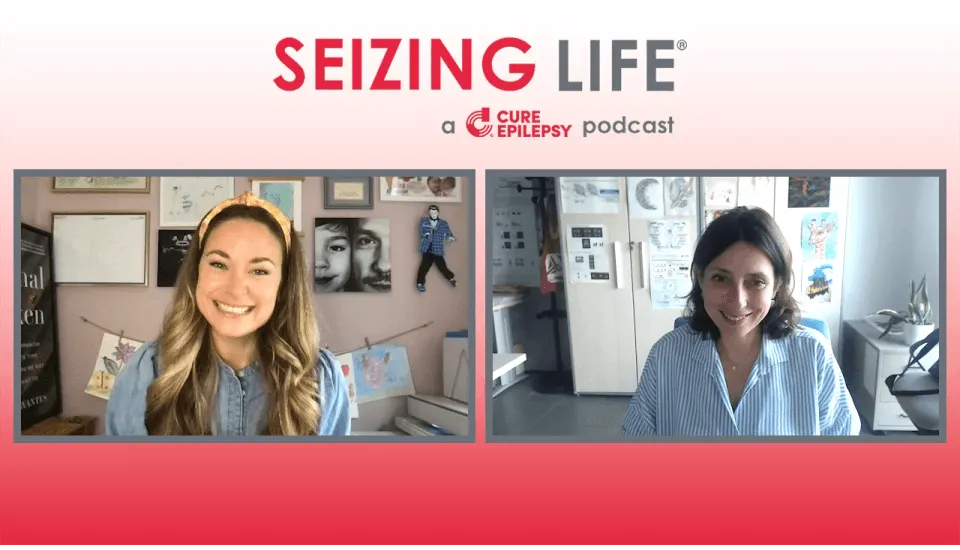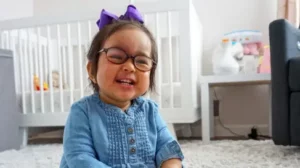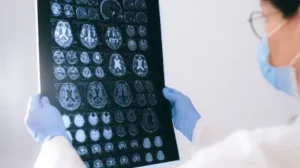Episode Overview
For many people with epilepsy and their families, the healthcare system can be a confusing and frustrating maze of questions, concerns, doctors, specialists, tests, bills and insurance claims. But for people of color, there can be added challenges to access due to implicit bias and (intentional or accidental) judgement. Research indicates that Black Americans are more likely to develop epilepsy over their lifetime, have higher seizure frequency, and experience a greater rate of Sudden Unexpected Death in Epilepsy (SUDEP) compared with White Americans.* As the country grapples with issues of race, discrimination, and inequality, we take a look at how these issues intersect with and impact the epilepsy management for Black families, particularly those which include a child with special needs.
Our guest this week is mother and advocate, Sherri Brady. At three years old, her daughter, Lauren was diagnosed with Rett Syndrome, a rare neurological disorder that can have devastating impacts, including seizures. For the past 20 years, Sherri has gathered the tools she needs to advocated for Lauren’s care in a biased system.
Recently Sherri contributed an essay to Seizing Life host Kelly Cervantes’ blog outlining the challenges of being a Black woman with a child who has special needs. Together Kelly and Sherri explore the issues raised in that essay and dive into additional information and advice. Sherri provides insights about her experiences in the healthcare system and shares her thoughts about how we might begin to address issues of bias and judgement to create a more empathetic, equal, and welcoming healthcare community.
For an overview of disparities in health care as they relate to epilepsy, and strategies to address them, watch our webinar Disparities in Epilepsy: Overcoming Barriers to Improve Care and Treatment Outcomes.
Episode Transcript
Kelly Cervantes: Hi, I’m Kelly Cervantes and this is Seizing Life, a biweekly podcast produced by Citizens United for Research in Epilepsy, CURE.
Today I’m excited to welcome Sherri Brady to the podcast. At three years old, Sherri’s daughter, Lauren, was diagnosed with Rett syndrome, a rare neurological disorder that affects brain development, and can result in a number of different impacts, including seizures. In addition to providing the best life possible for Lauren, Sherri raises awareness and funds for Rett syndrome, and is currently the Southern California regional rep for Rettsyndrome.org, and is also a parent volunteer for the Children’s Hospital of Los Angeles Rett clinic.
Lauren is now 23 years old. So for the past two decades, Sherry has been navigating the healthcare system, including physicians, therapists, state services, insurance companies, and support groups as a Black woman with a special needs child. With recent events in the U.S. bringing attention to the issue of race and inequalities in the country, Sherri wrote an essay reflecting on her experiences within the healthcare system, which I posted on my blog. Sherri is here today to talk about those experiences and her thoughts on how we address this. Sherri, thank you so much for joining us today. [inaudible] I think this is just such an important topic for us to address. However, first, I want to learn more about you and Lauren and how epilepsy first entered your lives.
Sherri Brady: Well, if it was one of those days. It was those early days of still trying to find what was going on with Lauren. At that point, I knew something was going on. Her development had sort of plateaued. Things were happening that shouldn’t have been and things weren’t happening that should. She was my first child.
Kelly Cervantes: And how old was she at the time?
Sherri Brady: It had to been a right around a year because 18 months is when she got her official diagnosis and it was prior to that. So this must’ve been right around a year. She was at daycare and I got a call. I was on my way to pick her up, but I got a call saying, “Hey, Lauren’s doing something strange. We don’t really know what, but you need to get here and you need to get here fast.” And of course, I probably broke all speed limits and rules of the law to get to the daycare as quickly as I could.
She just was shaking and just clearly was not herself, so took her to the hospital. They eventually said, “Okay, we think this was a febrile seizure.” Again, I knew some other things were going on with her, but I didn’t have an official diagnosis yet, so the hope was this was a one and done. This was just, she happened to be sick, she happened to get a high fever, and this was the end result. And so that got put the back burner and I moved forward with trying to get an overall diagnosis for her. Like I said, at 18 months, that was the first time that a doctor said they thought she had Rett syndrome.
Kelly Cervantes: Can you explain what Rett syndrome is for us?
Sherri Brady: Sure. Rett syndrome is a neurological disorder. The way I describe it basically it can affect a person from head to toe. I used to say affects girls because it was always thought that it was primarily girls that had Rett syndrome because it’s on the X chromosome, it’s a mutation on the X chromosome. So the thought was that boys typically did not survive. We are now seeing that there are lots of boys that are being now diagnosed with Rett syndrome. Some of them, they just had a different diagnosis or an incorrect diagnosis. But with progress, and science, and diagnoses, and all that type of thing, we’re actually finding more and more cases.
So what ends up happening is just depending on where that mutation is on that X chromosome, and how many quote unquote effective Xs are turned on, and how many of the non-affected Xs are turned on, will determine the extent to which Rett syndrome can affect the individual. Lauren falls right in the middle. She can walk with assistance, but not on her own. She has some hand use, but not really functional, so she can’t comb her hair, or tie her shoes, and those types of things.
She is unable to speak, but most definitely can communicate with her eyes, with her body, with her sounds in many, many ways. And that sometimes she communicates things I wish that she didn’t, but including like, “Oh my God, Mom, will you stop?” But amazing personality, really, really smart, and just an amazing person overall. So thankfully, there’s some things that Rett syndrome has not taken away from her and I love that.
Unfortunately, epilepsy is part of how Rett syndrome can manifest itself in an individual. So there are several of the individuals that have it that also develop seizures at one point in a time. So after that first febrile seizure, a few years later, it had to been right around three because Lauren was in school, and we were on a field trip. I was that mom that I went on every field trip, so I was on the bus with her.
And all of a sudden, I don’t know how I knew that it was a seizure, but I knew that that’s what it was. Because I don’t think I’d ever seen one other than maybe on TV prior to that. But it felt like forever. I’m sure it was probably only about 30 seconds. We were at the Natural History Museum in L.A. on a bus, on a school bus. I got a ride, we got to the hospital, and that started the process. Obviously, not right then and there did we have the official diagnosis of epilepsy, but it began the process. Unfortunately, those episodes continued, and medication needed to be started, and that’s the road that we’ve been on ever since.
Kelly Cervantes: So you know that Lauren has Rett syndrome and the seizures start to have a larger effect around the time that she’s three. But she’s now, correct me if I’m wrong, she’s 23, correct?
Sherri Brady: Yes.
Kelly Cervantes: So I want to chat about the essay that you wrote for my blog. In the essay, you spoke about the challenges of being Black, a woman, and having a special needs child, and these cross sectional identities, where you have experienced discrimination or been treated differently. Can you talk about some examples or different times that you’ve experienced this?
Sherri Brady: Well, I have to say, the good news is there haven’t been a lot of blatant experiences. Most of the times, it’s those things where after the fact you realize, “Hmm, wait, would that have happened if not for what we look like?” So for instance, a teacher or a doctor saying something, seeming to be overly surprised that Lauren is well cared for, and well kept, and clean. And I’m like, “Well yeah, of course she is. Why do you seem like you think that she wouldn’t be?” And to some degree, I try to convince myself, “Well, maybe that’s just about the fact that she has a disability,” but I know because I’ve seen it in other parts of my life. So I have to acknowledge after the fact, even if I don’t in that moment, that there is that bias there.
Am I saying that all these teachers and all these doctors that have said something like that are blatant racists? Absolutely not. But is there a bias there? Do they have an assumption about children that are Black or people of color and how they’re being taken care of? Absolutely, I believe that that’s there. A lot of the other things are more me knowing that I need to be proactive because of what I know exists. So I know that there are disparities in healthcare as far as what’s provided, depending on where you live, and what you look like, and what hospital you go to. So I have to go out of my way to make sure that I’m taking Lauren… I may not be able to just go to the closest local hospital or doctor because I know they’re not going to have what Lauren needs.
Kelly Cervantes: To your point, I’m sorry to interrupt you, but I’m always fascinated by the different studies going on. I know that Lauren had the opportunity to be involved in a study at USC. Can you tell us a little bit about that and what they were looking at?
Sherri Brady: What they were looking at was children with special needs that were African American and how that affected basically how they move through life. Was it harder to get care? Was it harder to get services? Was it harder to have doctors listen to you and believe and do what it was that you were asking them?
There was a wide variety of families that participated in age, and diagnosis, and where we lived, and all of that. But so many of the stories were very, very similar, which was sad. And that was that, “Yes, in various areas, there was a struggle.” There were those questions of, “Are you asking me this? Are you not doing this? My having to fight for this because of what I look like.” In many cases you had to believe that that’s exactly what was going on and address it, fight for it, move past it, deal with it, whatever the case.
Because at the end of the day, the part of it being that we were just families that were willing to participate in a research study was an indication of who we were as people, but all of us were like, “And yeah, and we fought for it, and the end result was my kid got what he needed,” but that just was because of who we were and how we were as parents. But realizing, as I mentioned earlier, that’s not always the case. And sadly, probably more often than not, that’s not the case. That’s not the end result.
Even just as women, women of color going to the hospital for, or going to a doctor’s office with a pain, or an ache, or something that truly is some life threatening illness. But whether it’s in childcare, having a child, or just any other health issue, it’s pushed aside, and now you don’t know what you’re talking about. And so again, I overcompensate. I go into doctor’s appointments, making sure that I know everything there is to know, so that they take me seriously, so they listen to what I’m saying, and so that they see me as an equal partner in figuring out what’s best for Lauren.
There was an example of a doctor that she went to early on before she was officially diagnosed with GERD. I realized in the first few appointments with him, it was like, okay, in his head, he had made up his mind that you have to have these particular symptoms in order to be diagnosed with reflux. Lauren wasn’t doing that. But I had also done my research, and I knew what she was doing, and I knew that that’s what she had. And so I was able to push, and push, and push. He finally, in a very condescending way, said, “Okay, fine. We’ll do the study,” just basically to prove me wrong. I know that’s what he was doing. Turns out, surprise, surprise, lauren had reflux.
Afterwards, he asked me, “Well, do you have a medical background?” And I’m like, ‘No, I’m a mom, and I’ve done my research, and I care about my child, and I want answers, but you couldn’t hear that before. Yeah. We had to go through all of this in order for you to respect what I’m saying to you, and hear the input that I was giving you.” Again, can I prove it? But no. But do I think that there was definitely a bias there of him not believing me? Absolutely.
Kelly Cervantes: There’s a phrase that a friend of mine taught me very early on, which is, “Just have the fight.” That teaching me that the doctors aren’t necessarily always right, and you know your child better than anybody else, so make sure that you have that fight. However, at no point, and this is my unawareness of my own privilege, did it dawn on me that I was not probably needing to have the fight. Or when I did push back, I was listened to significantly more than perhaps you would be in that same situation?
Sherri Brady: Right.
Brandon: Hi, this is Brandon from Citizens United for Research in Epilepsy or CURE. For the 65 million people worldwide living with epilepsy, progress is unacceptably slow. At CURE, our mission is to find a cure for epilepsy by promoting and funding patient focused research. Learn more at www.cureepilepsy.org. Now back to this episode of Seizing Life.
Kelly Cervantes: So you talk about these comments that you receive that are backhanded compliments perhaps is the best way. In those moments, how do you handle that? So if another mother who is in your position, what is your recommendation to them? How do you respond?
Sherri Brady: It’s really a case by case scenario type of situation. As with anything, when it comes to dealing with Lauren and other people, it depends on what mood I’m. It depends on what we’re currently dealing with as to whether I’m going to choose to make that a teachable moment. Whether I’m so upset that I don’t say anything because I know this is not going to end well for probably either one of us, and I’m going to say some things that I probably shouldn’t say, so it’s best for me to just not say anything.
And then sometimes, I may not say anything right then, but I definitely will Usually most of the time, I definitely will follow up. So for instance, like I said, there’s been times where in the moment either I’ll say something offhanded or draw their attention to it, they get it. Especially if I feel comfortable with the person because, again, a lot of these things, I don’t think they’re intentional. I think they’re just this bias that’s there and people do and say things that they don’t even realize that they’re doing and saying. So I’m going to address it. I’m going to call it out. We laugh about it and move on. Other times when I think it is a bigger problem, I’m going to address it a little bit more seriously, like I said, either in the appointment, or in that initial meeting, or after the fact.
And then there’s those times when I just do have to go there. There was a time when Lauren, I had to take her to the emergency room. She was having some pains off and on that I could not figure out what they were. But every time I finally got a doctor’s appointment for her, of course, she was fine during the appointment. So surprise, surprise all the tests came back normal. So this time I said, “Okay, she’s having these pain episodes right now. Let me take her to the ER right now so they can do the test and we can see if there’s anything going on in the moment when the pain is actually happening.”
So we did all that, the tests were done. Of course, they had had to put tape on her for IVs and all the different things that they had attached to her and it was time to take all of that off. A nurse walked in and I asked him for the adhesive remover so that I could take the tape off because I know my child has very sensitive skin. You can’t just pull. Even if it’s a simple bandaid, I don’t pull anything with adhesive off of Lauren’s skin without adhesive remover. Because when I’ve done it before, there’s been a reaction, anything from just slight redness to actual bleeding.
So I know, I know my kid, so I’m asking him for this. He’s like, “Yeah, I don’t know what you’re talking about. That’s not really needed. What are you talking about? You can just take it off.” I said, “No, I need it.” There was a back and forth. Next thing I know this hand is coming toward my child. It was all slow motion I think, like the words that were coming out of his mouth is “See, all you need to do is,” and he was about to rip the tape off of her arm. So I hit his arm away. Immediately told him to leave. Immediately called for supervisors. Immediately asked for the doctor.
And not only did I address it and deal with it in that moment with anybody and everybody that would listen including him… because I gave him a piece of my mind before I told him to leave… but I followed up with a letter after to make sure that everybody in that hospital knew what type of person that they had working for them. And if he was going to continue to work there, he needed to never do anything like that again. So there’s a range.
Kelly Cervantes: Good for you. Yeah, absolutely. What about when people claim to be colorblind? At the end of your essay, you wrote, “I’ve heard people say they don’t see race, or they don’t see someone’s disability. And in most cases, they mean well, but the answer is not to ignore any part of who a person is. The better option is to see all of them, all of their differences, then accept, appreciate, and respect them.” I love that part so much.
Sherri Brady: Well, I’ve always felt that way even before having a child with a disability, but now it’s tenfold that that’s my belief. Again, that’s another one of those situations where I know what people mean when they say that. But what I try to get folks to understand is it’s not seeing who we are that’s the problem. It’s seeing it and then making negative judgements and assumptions because of what you see that’s the problem. If you don’t see all of me, if you don’t see that I’m a woman, if you don’t see that I’m Black, if you don’t see, then you’re missing part of who I am as a person.
We’re all different. We are made up of our life’s experiences and all those different parts of ourselves. And so how can you truly appreciate and know me if you’re blocking out seeing part of who I am? And the same for Lauren. Obviously, Lauren rolls up in a wheelchair, so you can claim you don’t see her disability, but obviously you do, just like, obviously, you see the color of my skin.
But if you don’t acknowledge that Lauren has Rett syndrome and all of the challenges that come with that, if you don’t acknowledge that Lauren has seizures and deals with that in an amazing way on a daily basis, then you’re not giving Lauren all the credit and the glory of being who Lauren is. And so, how is that a good thing? Like I said, I think the focus needs to be on seeing people for who they are, and accepting, and respecting, and hopefully celebrating those differences. Because how boring would this world be if we were all exactly alike?
Kelly Cervantes: How do we approach raising awareness and educating perhaps within the special needs community, but certainly outside of it as well, when it comes to the differences that the Black special needs community is facing?
Sherri Brady: Well, I think the first step is what was behind what I wrote, which was, as you said, we fight for inclusivity. We want our kids to belong. We want them to be accepted. And as a special needs parent, I would hope you don’t have to experience Rett syndrome, and you don’t have to experience having a seizure in order to empathize with my child and what she deals with on a daily basis. You should not have to have a firsthand experience with something to hear that person and say, “Wow, okay, I hear what you’re saying. I believe you. And how can I help? How can I be a part of the solution and not a part of the problem?”
So that to me is the first step, especially as special needs parents, but the world in general is you should not have to have a firsthand experience to be able to empathize with something that you don’t. And again, I’m not saying understand. I’m not saying just accept it. But at least hear me and believe what I’m saying and have some empathy for what I’m telling you is my experience.
If you look through the eyes of a person of color and realize that my freedom, my existence, my right to vote has all needed to be legislated. Like that should have just existed when, as a person, you are born, and put on this earth, and live where you live. But it needed to be legislated. That’s huge. Again, when you stop and think that that’s how someone is living, even though you’ve never had that experience, but it’s also when your around friends, the acquaintances, coworkers, or what have you, and they’re saying and doing things that you know are not right, that you know are racist, and you don’t say anything, you’re a little bit complicit.
And I get that that’s hard. I just said in the situations with Lauren, sometimes I speak up, sometimes I don’t. It just depends on the scenarios. But there’s opportunity, and if you’re seeking those opportunities, if you’re open to those opportunities, where you can speak up and you can say something, if you work for a company, or you’re part of an organization, where you can make sure that that organization is more inclusive, and more welcoming, and more representative. Because that’s one of those other pieces to the puzzle. Representation matters.
And when you go through life on a daily basis, and yeah, you see yourself and different, whether it’s on TV or in a brochure for an organization, or on a website, you see someone that looks like you, that does make you feel a little bit better. It does make you feel like, “You know what? They’re talking to me too.” Where if you don’t, which is far too often the case, you can walk away thinking, “They’re not interested in me. They don’t want to know what I have to say. That’s not something that’s for me.” So making sure that we’re open to each other and that everybody feels welcome, not just Black people, but people with disabilities, all people of color, yeah, everybody.
Kelly Cervantes: Absolutely. I do think that the answers have to start from inside our community. I hope that those who are listening or watching, who read your piece on my blog, that they can take your words to heart, and can try and walk a day in your shoes, and experience what it is like to be Black, and have a special needs child, and have that empathy, even though they’re not in your skin. I just am so grateful to you for being willing to share your experiences and your thoughts because it’s so important. I don’t think that we hear enough from ethnically diverse voices in this community and I just am so appreciative. Thank you for sharing. Thank you for educating us. Please send Lauren our best.
Sherri Brady: 25:30 Thanks so much for the opportunity.
Kelly Cervantes: Thank you, Sherri, for speaking about your experiences and providing your perspective on the challenges of navigating the healthcare system with a special needs child. While we recognize that everyone may have different experiences and challenges parenting a special needs child, those challenges are multiplied when gender, race, and income are factors. As we engage in difficult and long overdue conversations about race and inequality, we must also address those found in healthcare. This gap runs counter to CURE’s mission and needs to be changed. We hope you will support us in our mission by visiting www.cureepilepsy.org/donate. Your generosity is greatly appreciated. Thank you.
Brandon Laughlin: The opinions expressed in this podcast do not necessarily reflect the views of CURE. The information contained herein is provided for general information only and does not offer medical advice or recommendations. Individuals should not rely on this information as a substitute for consultations with qualified healthcare professionals who are familiar with individual medical conditions and needs. CURE strongly recommends that care and treatment decisions related to epilepsy and any other medical condition be made in consultation with a patient’s physician or other qualified healthcare professionals, who are familiar with the individual’s specific health situation.





